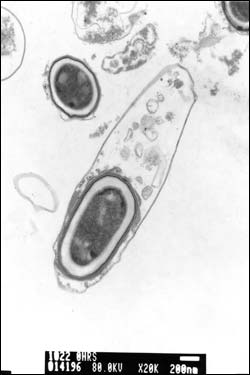From trigger to toxin – Clostridium botulinum exposed

Dormant spore prior to germination and outgrowth
A discovery by Institute of Food Research (IFR) scientists is set to improve the food industry’s ability to predict foodborne botulism.
Botulism is a severe and often deadly disease caused by toxin-producing spores of the bacterium Clostridium botulinum. The spores remain harmless until they find a suitable, anaerobic environment in which to germinate. After germination, there is a short “lag time” until rapid cell division begins.
Lead author of the newly published study Dr Sandra Stringer said: “We set out to unravel the various stages within lag time leading to the production of deadly neurotoxin. This is like looking at the time between loading a gun and actually pulling the trigger.”
Spores are the time travellers of the bacterial world. They are produced at times of environmental stress and exist in a state of suspended animation. In the protective pod of a spore coat, they resist temperature extremes and dehydration and can survive for millions of years until conditions are ripe for germination.
A single spore of Clostridium botulinum can lead to neurotoxin production in food. Previous studies have found that the lower the number of spores, the more difficult it is to predict growth patterns. However, prediction of lag time has until now been based on the belief that the first spore to germinate will be the first to produce actively dividing cells and start toxin production.
The IFR study is the first to investigate each stage within lag time and the relationship between them.
“The only way to study each stage in detail is by using microscopy and image analysis”, said Dr Stringer. “We developed a novel imaging system and made microscopic observations of 1,739 spores. We tracked their irreversible progress through germination and rehydration to shedding the spore coat, emerging as a young cell, maturing and finally beginning cell division.
“We found that each stage from germination to growth is variable between individual spores and none of the stages are related. Germination is therefore not a good predictor to use in risk assessment work as it underestimates the time to growth and toxin production”, said Dr Stringer.
Images of individual spores were captured every five minutes for 15 hours then analysed.
“This was painstaking work, but worth it”, said Dr Stringer.
Mathematical biologist Dr Gary Barker says the findings have immediate practical benefits: “This fundamental science can be incorporated into real risk assessments for real products. Food companies can approach us for microbial risk assessments of specific products based on a model we have developed that reflects on the variability of spore lag time.”
Media Contact
More Information:
http://www.ifr.ac.ukAll latest news from the category: Life Sciences and Chemistry
Articles and reports from the Life Sciences and chemistry area deal with applied and basic research into modern biology, chemistry and human medicine.
Valuable information can be found on a range of life sciences fields including bacteriology, biochemistry, bionics, bioinformatics, biophysics, biotechnology, genetics, geobotany, human biology, marine biology, microbiology, molecular biology, cellular biology, zoology, bioinorganic chemistry, microchemistry and environmental chemistry.
Newest articles

A universal framework for spatial biology
SpatialData is a freely accessible tool to unify and integrate data from different omics technologies accounting for spatial information, which can provide holistic insights into health and disease. Biological processes…

How complex biological processes arise
A $20 million grant from the U.S. National Science Foundation (NSF) will support the establishment and operation of the National Synthesis Center for Emergence in the Molecular and Cellular Sciences (NCEMS) at…

Airborne single-photon lidar system achieves high-resolution 3D imaging
Compact, low-power system opens doors for photon-efficient drone and satellite-based environmental monitoring and mapping. Researchers have developed a compact and lightweight single-photon airborne lidar system that can acquire high-resolution 3D…





















